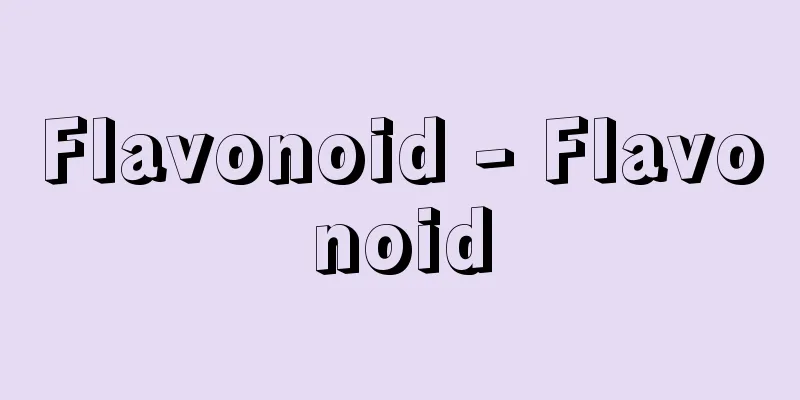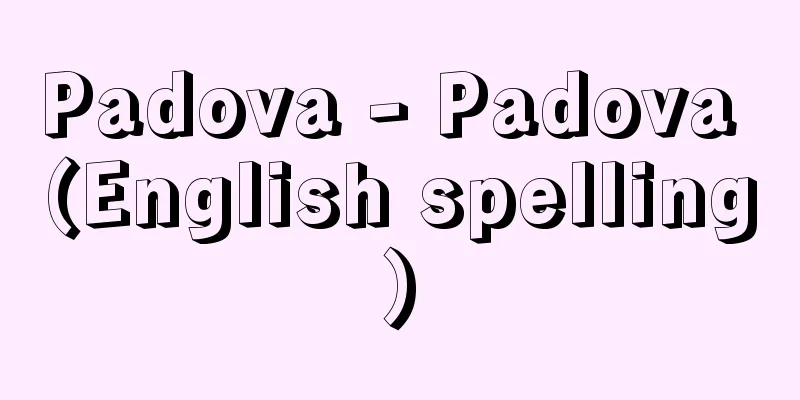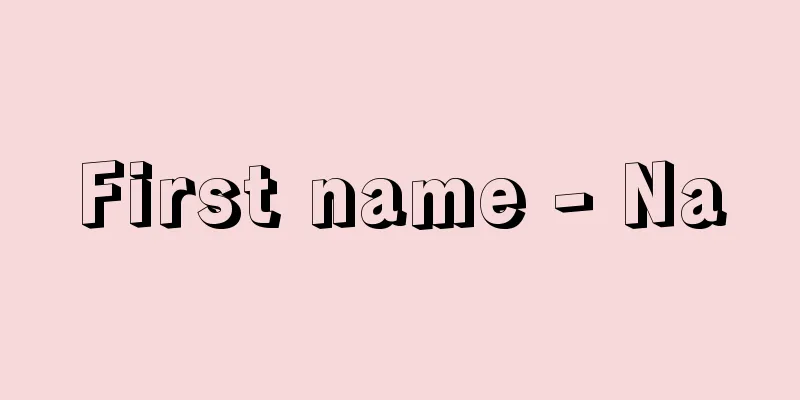Flavonoid - Flavonoid

|
A general term for a group of plant pigments, along with chlorophyll and carotenoids. They have a structure in which two benzene rings are connected by three carbon atoms, and the central C3 forms a heterocyclic ring containing oxygen. Depending on the redox state of the heterocyclic ring, they are classified into flavones, isoflavones, flavonols, flavanones, anthocyanins, and catechins (flavanols). They are found in various parts of plants, such as leaves and flowers, and are widely distributed in higher plants. Representative examples are yellow flavone pigments and anthocyanin pigments that produce the red, purple, and blue colors of flowers. The former are chemically stable and some are used as dyes, but the latter are unstable substances that easily change color due to differences in light and hydrogen ion concentration index (pH), and cannot be used as dyes. Flavonoids are produced in plants by the fusion of malonyl CoA, which is made from three molecules of acetic acid units, and cinnamic acids derived from phenylalanine. Flavonoids absorb ultraviolet light well, so higher plants contain these pigments in their epidermis to prevent damage caused by ultraviolet light. [Seiichi Yoshida and Takao Minamikawa] The name flavonoid comes from flavone, and was coined after terpenoids and carotenoids. They are yellow pigments found in trees, and many of them have physiological activity. As of 2003, about 600 types of flavonoid pigments have been isolated from plants. The word flavone comes from the Latin word flavas, which means "yellow." [Kikumasa Sato] FlavoneThe parent compound of flavones is called 2-phenylchromone, which is sometimes called flavone. It was isolated as colorless needle-like crystals from the leaves and fruits of primrose by the German Müller in 1914. It is insoluble in water, slightly soluble in petroleum ether, and easily soluble in ethanol. Its melting point is 97°C. It dissolves in concentrated sulfuric acid to give a solution with purple-blue fluorescence. It is obtained by reacting 2-acetoxychalcone dibromide with potassium alcohol. Its derivatives are widely distributed in higher plants, and representative examples include chrysin and luteolin. Chrysin was isolated as pale yellow small crystals from young poplar shoots. It is easily soluble in ethanol and glacial acetic acid, but insoluble in benzine. Its melting point is 274°C. It is obtained by treating 2,4,6-trimethoxybenzoylacetophenone with hydrogen iodide. Flavones are chemically stable and have been used as dyes for a long time. [Kikumasa Sato] IsoflavonesThe parent compound of isoflavones is called 3-phenylchromone, which is sometimes called isoflavone. However, it does not exist in nature. It is a colorless needle-like crystal that emits blue fluorescence when dissolved in concentrated sulfuric acid, but gradually turns brown. Its melting point is 131°C. Its derivatives are distributed only in the families Fabaceae, Rosaceae, Iridaceae, Mulberry and Amaranthaceae. Genistein and daidzein are known, but these have an aphrodisiac effect similar to estrone (a type of steroid hormone). [Kikumasa Sato] FlavonolFlavonols are a general term for flavone derivatives that have a hydroxyl group at the 3-position of 2-phenylchromone. The parent compound is 3-hydroxyflavone. Flavonols are widely distributed in the plant kingdom, and many of them exist as glycosides with the hydroxyl group at the 3-position. Representative examples include galangin, fisetin, and quercetin. Galangin is a yellow needle-like crystal isolated from the roots of galanga. Its melting point is 215°C. Its structure was determined because phloroglucin and benzoic acid were obtained by hydrolysis. [Kikumasa Sato] FlavanonesFlavanones are a general term for compounds in which the double bonds at the 2- and 3-positions of 2-phenylchromone are saturated, and their derivatives. Flavanone derivatives are not found in large quantities in nature, but they can be obtained from the Fabaceae and Rutaceae families. Flavanones are colorless, needle-like crystals with a melting point of 76°C. When they are mixed with a concentrated aqueous solution of potassium hydroxide and heated, the heterocyclic ring is cleaved. This reaction, like that of flavones, is important for determining the structure. For example, hydrolysis of liquiritigenin gave resacetophenone and p (para)-hydroxybenzoic acid, which allowed the structure to be elucidated. [Kikumasa Sato] AnthocyanAnthocyanins are found in the beautifully colored parts of plant flowers, leaves, and fruits, and are red in acidic solutions and blue in alkaline solutions. The pigment that gives the color (aglycone) is called anthocyanidin, and when sugar is bound to this (pigment glycoside), it is called anthocyanin; together, the two are called anthocyanins. Commercially available anthocyanin pigments (natural edible pigments) include shisonin (perilla pigment), delphinidin (hibiscus pigment), and malvin (grape juice pigment). The wide variety of flower colors caused by these anthocyanin pigments is not due to the pH of the flower cells, but due to the chelation of anthocyanins with metal ions and the regular intramolecular and intermolecular associations of anthocyanins. Applications include beverages, Western liquor, pickled plums, pickled shiba, frozen desserts, and Western sweets. [Kikumasa Sato] "Handbook of Natural Colorants" edited by Tanimura Akio, Katayama Osamu, et al. (1979, Korin)" ▽ "Color Chemical Dictionary" edited by Tobita Mitsuhiko (1988, Kosaido) ▽ "Natural Products Chemistry" edited by Mitsuhashi Hiroshi, Tanaka Osamu, Nozoe Shigeo, and Nagai Masahiro (1992, Nanzando) ▽ "The Medicine of Flavonoids" edited by Yoshikawa Toshikazu (1998, Kodansha) ▽ "Animal Pigments - A World of Diverse Colors" by Umebachi Yukishige (2000, Uchida Rokakuho) [References] | | | | | | | | | | |Note: (1) to (6) The parent compound is on the left and the derivatives are on the right . ©Shogakukan Classification of flavonoids (1) It is obtained by reacting 2-acetoxychalcone dibromide with potassium hydroxide. (2) It is obtained by treating 2,4,6-trimethoxybenzoylacetophenone with hydrogen iodide . Methods for producing flavones ©Shogakukan "> Hydrolysis of galangin ©Shogakukan "> Hydrolysis of liquiritigenin Source: Shogakukan Encyclopedia Nipponica About Encyclopedia Nipponica Information | Legend |
|
クロロフィル、カロチノイドと並ぶ一群の植物色素の総称。ベンゼン環2個が炭素3個で結ばれ、かつ中央のC3が酸素を含むヘテロ環をつくった構造をしている。ヘテロ環の酸化還元状態の違いによってフラボン類、イソフラボン類、フラボノール類、フラバノン類、アントシアン類、カテキン類(フラバノール類)などに分類される。植物の葉、花など各部分に含まれ、高等植物に広く分布している。代表的なものは黄色のフラボン系色素と、花などの赤・紫・青を現すアントシアン系色素で、前者は化学的にも安定で染料として利用されるものもあるが、後者は光や水素イオン濃度指数(pH)の違いなどによって変色しやすい不安定な物質で染料にはならない。フラボノイドは植物体内では3分子の酢酸単位からできるマロニルCoAとフェニルアラニンに由来する桂皮酸類が融合して生成する。フラボノイドは紫外線をよく吸収するので、高等植物はこれらの色素を表皮に含み、紫外線による障害を防いでいるといわれる。 [吉田精一・南川隆雄] フラボノイドという名称はフラボンに由来しており、テルペノイドやカロチノイドに倣って称されるようになった。樹木の黄色の色素で生理活性を有するものが多く、2003年現在、600種ほどのフラボノイド系色素が植物から単離されている。なお、フラボンはラテン語で「黄色」を意味するflavasが語源である。 [佐藤菊正] フラボン類flavoneフラボン類の母体化合物は2-フェニルクロモンとよばれ、これをフラボンということがある。1914年にドイツのミュラーMüllerによってサクラソウの葉や実から無色の針状結晶として単離された。水に不溶、石油エーテルに難溶、エタノールに易溶。融点97℃。濃硫酸に溶けて、紫青色の蛍光をもつ溶液となる。2-アセトキシカルコンジブロミドに、酒精性カリを作用させると得られる。この誘導体は高等植物に広く分布しており、代表的なものはクリジンchrysin、ルテオリンなどである。クリジンはポプラの若芽から淡黄色の小片結晶として単離された。エタノール、氷酢酸に易溶、ベンジンに不溶。融点274℃。2,4,6-トリメトキシベンゾイルアセトフェノンをヨウ化水素で処理すると得られる。フラボン類は化学的に安定で、古くから染料として用いられている。 [佐藤菊正] イソフラボン類isoflavoneイソフラボン類の母体化合物は3-フェニルクロモンというが、これをイソフラボンということもある。しかし天然には存在していない。無色の針状結晶で、濃硫酸に溶けて青い蛍光を発するが、徐々に褐色となる。融点131℃。この誘導体の分布はマメ科、バラ科、アヤメ科、クワ科およびヒユ科に限られている。ゲニステインやダイゼインなどが知られているが、これらはエストロン(ステロイドホルモンの一種)と同様に発情作用がある。 [佐藤菊正] フラボノール類flavonolフラボノール類は2-フェニルクロモンの3位にヒドロキシ基をもつフラボン誘導体の総称。母体化合物は3-ヒドロキシフラボンである。フラボノール類は植物界に広く分布しており、その多くは3位のヒドロキシ基が配糖体となって存在している。代表的なものはガランギンgalangin、フィゼチンFisetin、ケルセチン(クェルセチン)Quercetinなどである。ガランギンはガランガの根から単離された黄色の針状結晶。融点215℃。この加水分解によってフロログルシンと安息香酸が得られたことから、この構造が決定された。 [佐藤菊正] フラバノン類flavanoneフラバノン類は2-フェニルクロモンの2、3位の二重結合が飽和された化合物およびその誘導体の総称である。フラバノン誘導体は天然にはあまり多く存在していないが、マメ科、ミカン科などから得られている。フラバノンは無色の針状結晶。融点76℃。これを濃水酸化カリウム水溶液と混合して加熱すると、複素環部分が開裂する。この反応はフラボンの場合と同様、構造決定に重要である。たとえば、リキリチゲニンを加水分解するとレスアセトフェノンとp(パラ)‐ヒドロキシ安息香酸が得られたのでその構造が明らかにされた。 [佐藤菊正] アントシアン類anthocyanアントシアン類は植物の花、葉、および果実の美しい色をもった部分に存在し、酸性溶液中では紅色を呈し、アルカリ性溶液中では青色を呈する。発色のもとになる色素の本体(アグリコン)をアントシアニジンanthocyanidin、これに糖が結合したもの(色素配糖体)をアントシアニンといって、この両者をあわせてアントシアンと称している。市販のアントシアニン色素(食用天然色素)としてはシソニン(シソ色素)、デルフィニジン(ハイビスカス色素)、マルビン(ブドウ果汁色素)などが知られている。これらアントシアニン色素による千差万別の花の色は、花卉(かき)細胞のpHによるものではなくて、アントシアニンと金属イオンとのキレート形成やアントシアニンの規則正しい分子内または分子間の会合によるものである。用途として飲料、洋酒、梅漬け、柴漬け、冷菓、洋菓子などがある。 [佐藤菊正] 『谷村顕雄・片山脩他編『天然着色料ハンドブック』(1979・光琳)』▽『飛田満彦編『カラーケミカル事典』(1988・広済堂)』▽『三橋博・田中治・野副重男・永井正博編『天然物化学』(1992・南江堂)』▽『吉川敏一編『フラボノイドの医学』(1998・講談社)』▽『梅鉢幸重著『動物の色素――多様な色彩の世界』(2000・内田老鶴圃)』 [参照項目] | | | | | | | | | | |注:(1)~(6)各図の左が母体化合物、右がその誘導体例である©Shogakukan"> フラボノイドの分類 (1)2-アセトキシカルコンジブロミドに、酒精性カ性カリを作用させると得られる。(2)2,4,6-トリメトキシベンゾイルアセトフェノンをヨウ化水素で処理すると得られる©Shogakukan"> フラボン類の製法 ©Shogakukan"> ガランギンの加水分解 ©Shogakukan"> リキリチゲニンの加水分解 出典 小学館 日本大百科全書(ニッポニカ)日本大百科全書(ニッポニカ)について 情報 | 凡例 |
Recommend
Volcanic Ash Chronology - Volcanic Ash Chronology
…also known as tephra chronology. Large-scale vol...
Avanti
…The term mahājanapada translates to “great count...
Ipswich (English spelling)
The capital of Suffolk County in the east of Engla...
Grants-in-Aid for Scientific Research
"Grant-in-Aid for Scientific Research" i...
Hatahata (sailfin sandfish) - Hatahata (English spelling)
A marine fish of the family Padae in the order Per...
Shirakawa-go
This refers to the area in the western part of th...
Copper spear - Please
A bronze weapon with a blade attached at a right ...
Tsunemasa Watarai - When is it good?
A priest at Toyouke Daijingu (Ise Jingu Geku) in ...
Ginkgo Acid - Ginkgo
…The outer layer of the seed coat is juicy, looks...
disintegration per second
… The probability that a certain nuclide of a cer...
Men's things - Otokodemono
...A type of Kabuki-Kyogen/Ningyo-Joruri with the...
FA (Factory Automation)
…The term office automation itself was first used...
Orton Rock, the Tailor-Poet
…He was once a professor of modern history at Cam...
O'Connell
Irish nationalist. Elected to the British House of...
Ama
...The name of a piece of gagaku or bugaku music....









